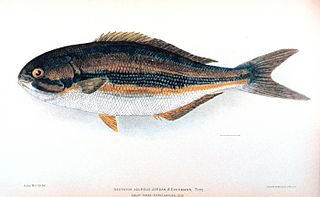
The term carp is a generic common name for numerous species of freshwater fish from the family Cyprinidae, a very large clade of ray-finned fish mostly native to Eurasia. While carp are prized quarries and are valued as both food and ornamental fish in many parts of the Old World, they are generally considered useless trash fish and invasive pests in many parts of Africa, Australia and most of the United States.

Cypriniformes is an order of ray-finned fish, which includes many families and genera of cyprinid fish, such as barbs, gobies, loaches, botias, and minnows. Cypriniformes is an “order-within-an-order”, placed under the superorder Ostariophysi—which is also made up of cyprinid, ostariophysin fishes. The order contains 11-12 families, over 400 genera, and more than 4,250 named species; new species are regularly described, and new genera are recognized frequently. Cyprinids are most diverse in South and Southeast Asia, but are entirely absent from Australia and South America. At 112 years old, the longest-lived cypriniform fish documented is the bigmouth buffalo.

Leuciscus is a genus of fish belonging to the family Cyprinidae. They are inland water fishes commonly called Eurasian daces. The genus is widespread from Europe to Siberia. Species broadly distributed in Europe include the common dace Leuciscus leuciscus and the ide L. idus.

Rhinichthys, known as the riffle daces, is a genus of freshwater fish in the carp family (Cyprinidae) of the order Cypriniformes. The type species is Rhinichthys atratulus, the blacknose dace. Rhinichthys species range throughout North America.

Shiner is a common name used in North America for any of several kinds of small, usually silvery fish, in particular a number of cyprinids, but also e.g. the shiner perch.
The Tennessee dace is a species of ray-finned fish in the family Cyprinidae. It is found only in the United States; particularly in northeast Tennessee and southwest Virginia, and parts of extreme northwest Georgia. Until recently, they were considered a subspecies of mountain redbelly dace. They are commonly found in East Tennessee in spring fed first-order streams, often in silt and fine gravel pools, or undercut banks. These streams usually do not exceed two meters in width.

Semotilus is the genus of creek chubs, ray-finned fish in the family Cyprinidae. The term "creek chub" is sometimes used for individual species, particularly the common creek chub, S. atromaculatus. The creek chub species of minnows can grow from 6 to 10 inches. They can be found in the United States and Canada in any small stream or creek. They hide under small rocks for protection. They have a small black spot on the dorsal fin for easy identification.

Chub is a common fish name. It pertains to any one of a number of ray-finned fish in several families and genera. In the UK, the term chub usually refers to the species Squalius cephalus. In addition, see sea chub.

The redside dace is a species of ray-finned fish in the family Cyprinidae, found in the United States and Canada. It is unique among minnows, being the only species to routinely feed on flying insects by leaping from water. Thus, it acts as a conduit for nutrient transfers between terrestrial and aquatic environments. The species can be used as an ecosystem health indicator, as it is sensitive to environmental disturbances.
Dendronucleata is a genus of small parasitic spiny-headed worms. It is the only genus in the family Dendronucleatidae. This genus contains three species that are distributed globally, being collected in North America and Asia. The distinguishing features of this genus among Archiacanthocephalans is the presence of randomly distributed dendritically branched giant hypodermic nuclei. Dendronucleata parasitize freshwater fish and a salamander by attaching themselves in the intestines using their hook covered proboscis and adhesives secreted from cement glands.

Cirrhinus molitorella is a species of ray-finned fish in the genus Cirrhinus found mainly in southern China and Vietnam.

Leuciscinae is a subfamily of the freshwater fish family Cyprinidae, which contains the true minnows.

The northern pearl dace is a freshwater ray-finned fish in the family Cyprinidae, the carps and minnows. It occurs in Atlantic, Hudson Bay, Great Lakes, and Mississippi River basins in the northern United States and Canada. Its preferred habitat is cool, clear headwater streams, bog drainage streams, ponds and small lakes, and in stained, peaty waters of beaver ponds, usually over sand or gravel.

The big-scaled redfin, also known as the Japanese dace and ugui, is a medium-sized Asian fish. First described by Albert Günther in 1877 as Leuciscus hakonensis, it is the type specimen of the genus Tribolodon, having been described again as Tribolodon punctatum by Henri Émile Sauvage when he established that genus in 1883. It is the most widely distributed of the Tribolodon species, found over much of the Sea of Japan. It is known to carry a number of parasites, including the trematode species Centrocestus armatus, and the copepod species Ergasilus fidiformis, which is carried in the fish's gills.
This page is based on this
Wikipedia article Text is available under the
CC BY-SA 4.0 license; additional terms may apply.
Images, videos and audio are available under their respective licenses.












